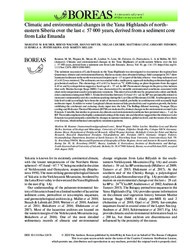Climatic and environmental changes in the Yana Highlands of north‐eastern Siberia over the last c. 57 000 years, derived from a sediment core from Lake Emanda
Baumer, Marlene M.
Lenz, Matthias
Fedorov, Grigory
Baumer, Marlene M.; Wagner, Bernd; Meyer, Hanno; Leicher, Niklas; Lenz, Matthias; Fedorov, Grigory; Pestryakova, Luidmila A.; Melles, Martin, 2020: Climatic and environmental changes in the Yana Highlands of north‐eastern Siberia over the last c. 57 000 years, derived from a sediment core from Lake Emanda. In: Boreas, Band 50, 1: 114 - 133, DOI: 10.23689/fidgeo-4421.
 |
Dokument öffnen: |
The sediment succession of Lake Emanda in the Yana Highlands was investigated to reconstruct the regional late Quaternary climate and environmental history. Hydro‐acoustic data obtained during a field campaign in 2017 show laminated sediments in the north‐western and deepest (up to ̃15 m) part of the lake, where a ̃6‐m‐long sediment core (Co1412) was retrieved. The sediment core was studied with a multi‐proxy approach including sedimentological and geochemical analyses. The chronology of Co1412 is based on 14C AMS dating on plant fragments from the upper 4.65 m and by extrapolation suggests a basal age of c. 57 cal. ka BP. Pronounced changes in the proxy data indicate that early Marine Isotope Stage (MIS) 3 was characterized by unstable environmental conditions associated with short‐term temperature and/or precipitation variations. This interval was followed by progressively colder and likely drier conditions during mid‐MIS 3. A lake‐level decline between 32.0 and 19.1 cal. ka BP was presumably related to increased continentality and dry conditions peaking during the Last Glacial Maximum (LGM). A subsequent rise in lake level could accordingly have been the result of increased rainfall, probably in combination with seasonally high meltwater input. A milder or wetter Lateglacial climate increased lake productivity and vegetation growth, the latter stabilizing the catchment and reducing clastic input into the lake. The Bølling‐Allerød warming, Younger Dryas cooling and Holocene Thermal Maximum (HTM) are indicated by distinct changes in the environment around Lake Emanda. Unstable, but similar‐to‐present‐day climatic and environmental conditions have persisted since c. 5 cal. ka BP. The results emphasize the highly continental setting of the study site and therefore suggest that the climate at Lake Emanda was predominantly controlled by changes in summer insolation, global sea level, and the extent of ice sheets over Eurasia, which influenced atmospheric circulation patterns.
Statistik:
ZugriffsstatistikSammlung:
- Geologie [933]
This is an open access article under the terms of the Creative Commons Attribution License, which permits use, distribution and reproduction in any medium, provided the original work is properly cited.

